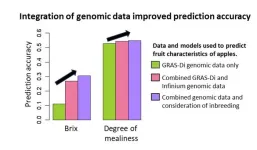(Press-News.org) A multidisciplinary research team has developed a discovery platform to probe the function of genes involved in metabolism — the sum of all life-sustaining chemical reactions.
The investigators used the new platform, called GeneMAP (Gene-Metabolite Association Prediction), to identify a gene necessary for mitochondrial choline transport. The resource and derived findings were published July 8 in the journal Nature Genetics.
“We sought to gain insight into a fundamental question: ‘How does genetic variation determine our “chemical individuality” — the inherited differences that make us biochemically unique?” said Eric Gamazon, PhD, associate professor of Medicine in the Division of Genetic Medicine at Vanderbilt University Medical Center. Gamazon is the senior and co-corresponding author of the study with Kivanç Birsoy, PhD, of The Rockefeller University.
Metabolic reactions play critical roles in nutrient absorption, energy production, waste disposal, and synthesis of cellular building blocks including proteins, lipids and nucleic acids. About 20% of protein-coding genes are dedicated to metabolism, including genes that code for small-molecule transporters and enzymes, Gamazon said.
Abnormalities in metabolic functions are associated with a range of disorders including neurodegenerative diseases and cancers.
“Despite decades of research, many metabolic genes still lack known molecular substrates. The challenge is in part due to the enormous structural and functional diversity of the proteins,” Gamazon said.
To discover functions for “orphan” transporters and enzymes — proteins with unknown substrates — the researchers developed the GeneMAP discovery platform. They used datasets from two independent large-scale human metabolome genome-wide/transcriptome-wide association studies and demonstrated with in silico validation that GeneMAP can identify known gene-metabolite associations and discover new ones. In addition, they showed that GeneMAP-derived metabolic networks can be used to infer the biochemical identity of uncharacterized metabolites.
To experimentally validate new gene-metabolite associations, the researchers selected their top finding (SLC25A48-choline) and performed in vitro biochemical studies. SLC25A48 is a mitochondrial transporter that did not have a defined substrate for transport. Choline is an essential nutrient used in multiple metabolic reactions and in the synthesis of cell membrane lipids.
The researchers showed that SLC25A48 is a genetic determinant of plasma choline levels. They further conducted radioactive mitochondrial choline uptake assays and isotope tracing experiments to demonstrate that loss of SLC25A48 impairs mitochondrial choline transport and synthesis of the choline downstream metabolite betaine.
They also investigated the consequences of the relationship between SLC25A48 and choline on the human medical phenome (symptoms, traits and diseases listed in electronic health records) using large-scale biobanks (UK Biobank and BioVU). They identified eight disease associations.
“What’s exciting about this study is its interdisciplinarity — the combination of genomics and metabolism to identify a long-sought mitochondrial choline transporter,” Gamazon said. “We think, given the extensive in silico validation studies in independent datasets and the proof-of-principle experimental studies, our approach can help identify the substrates of a wide range of enzymes and transporters, and ‘deorphanize’ these metabolic proteins.”
Birsoy is Chapman-Perelman Associate Professor, Head of the Laboratory of Metabolic Regulation and Genetics at The Rockefeller University, and a Searle and Pew-Stewart Scholar. Co-authors of the study include Artem Khan, Gokhan Unlu, PhD, (who completed his doctoral degree at Vanderbilt), Yuyang Liu, Ece Kilic and Timothy Kenny, PhD, at Rockefeller, and Phillip Lin at VUMC.
The research was supported by the National Institutes of Health (grants F99CA284249, F32DK127836, R01DK123323, R01HG011138, R01GM140287, R56AG068026, U24OD035523, R35HG010718), Boehringer Ingelheim Fonds PhD Fellowship, and Damon Runyon Cancer Research Foundation.
END
GeneMAP discovery platform will help define functions for ‘orphan’ metabolic proteins
Combining genomics and metabolism identifies long-sought mitochondrial choline transporter
2024-07-08
ELSE PRESS RELEASES FROM THIS DATE:
Zero-emissions trucks alone won't cut it: Early retirement of polluters key to California's emission goals
2024-07-08
California must implement early retirement for existing heavy-duty vehicles as well as introducing zero-emissions vehicles (ZEVs) to protect Black, Latino and vulnerable communities and hit net zero greenhouse gas (GHG) emissions targets by 2045. This is the outcome of a new study published in Environmental Research: Infrastructure and Sustainability by researchers from Stanford University and Arizona State University.
Stringent policies for mandating both ZEVs and early vehicle retirement could reduce cumulative emissions by two-thirds (64%) and reduce half of pollution-related mortality, particularly among disadvantaged communities.
California is the world’s 5th largest ...
Hexagonal perovskite oxides: Electrolytes for next-generation protonic ceramic fuel cells
2024-07-08
This study presents a significant advancement in fuel cell technology. Researchers from Tokyo Tech identified hexagonal perovskite-related Ba5R2Al2SnO13 oxides (R = rare earth metal) as materials with exceptionally high proton conductivity and thermal stability. Their unique crystal structure and large number of oxygen vacancies enable full hydration and high proton diffusion, making these materials ideal candidates as electrolytes for next-generation protonic ceramic fuel cells that can operate at intermediate temperatures without degradation.
Fuel cells offer a promising solution for clean energy by combining hydrogen and oxygen to generate electricity, ...
Genomic data integration improves prediction accuracy of apple fruit traits!
2024-07-08
Over the past few decades, the world has witnessed tremendous progress in the tools used for genomic analysis. While it’s usually more common to associate these tools with the fields of biology and medicine, they have proven to be very valuable in agriculture as well. Using numerous DNA markers obtained from next-generation sequencing technologies, breeders can make genomic predictions and select promising individuals based on based on their predicted trait values.
Various systems and methodologies aimed at improving the ...
Visualizing short-lived intermediate compounds produced during chemical reactions
2024-07-08
Immobilizing small synthetic molecules inside protein crystals proves to be a promising avenue for studying intermediate compounds formed during chemical reactions, report scientists from Tokyo Tech. By integrating this method with time-resolved serial femtosecond crystallography, they successfully visualized reaction dynamics and rapid structural changes occurring within reaction centers immobilized inside protein crystals. This innovative strategy holds significant potential for the intelligent design of drugs, catalysts, and functional materials.
Most complex chemical reactions, whether synthetic or biological, do not involve ...
It’s time to rethink our attitude to fatness, academic argues
2024-07-08
Prejudice against fat people is endemic in our society and public health initiatives aimed at reducing obesity have only worsened the problem, according to a U.S. academic.
In her new book Why It’s OK To Be Fat, Rekha Nath, an Associate Professor of Philosophy at the University of Alabama, argues for a paradigm shift in how society approaches fatness.
According to Nath, society must stop approaching fatness as a trait to rid the population of, and instead fatness should be approached through the lens of social equality, attending to the systematic ways that society penalizes fat people for their body size.
Nath explains: “Being fat is seen as unattractive, as gross even. ...
Braiding community values with science is key to ecosystem restoration
2024-07-08
Up on the “roof of the world”, one of the world’s largest ecosystem restoration projects is taking place. The Qinghai-Tibetan Plateau (QTP) in western China is the world’s highest plateau and covers a land area roughly five times the size of France.
Home to thousands of rare plants and wildlife and the source of water for more than 2.5 billion people, this vital ecosystem is under threat.
The region’s grassland is degrading due to climate change and intense livestock grazing. Government ...
Study of key characteristics of politicians reveals ‘ambition, narcissism, genuine idealism’ among common traits
2024-07-08
In a new study of politicians’ personalities, humour, charm and raw courage are listed among the most important character traits for successful leaders.
Bill Jones, Honorary Professor of Political Studies at Liverpool Hope University, has combed through biographies and interviewed key political figures to understand the kind of people who enter politics, and strengths and frailties of those who occupy positions of power.
Jones explains: “Why do aspiring politicians embark on such a perilous journey, involving hugely long hours, no real job security and, on occasions, high degrees ...
Air pollution linked to a decrease in IVF birth rate success, new study shows
2024-07-08
A pioneering study, presented today at the ESHRE 40th Annual Meeting in Amsterdam, has revealed that exposure to fine particulate matter (PM) prior to the retrieval of oocytes (eggs) during in vitro fertilisation (IVF) can reduce the odds of achieving a live birth by almost 40% [1].
The study analysed PM10 exposure in the two weeks leading up to oocyte collection, finding that the odds of a live birth decreased by 38% (OR 0.62, 95% CI 0.43-0.89, p=0.010) when comparing the highest quartile of exposure (18.63 to 35.42 µg/m3) to the lowest quartile (7.08 to 12.92 µg/m3).
Conducted ...
Gestational carriers face higher health risks during pregnancy compared to IVF and natural conceptions, new study shows
2024-07-08
Gestational carriers, also known as surrogates, experience an elevated risk of severe maternal morbidity and adverse pregnancy outcomes compared to women who conceive naturally or through in vitro fertilisation (IVF), according to new research presented today at the ESHRE 40th Annual Meeting in Amsterdam [1].
The population-based study analysed 937,938 singleton births in Ontario, Canada between 2012 and 2021, comparing outcomes among unassisted conceptions, IVF conceptions and gestational carriers.
The findings uncovered marked variations in outcomes across the different conception methods. Gestational carriers faced a severe maternal morbidity rate ...
Novel treatment improves embryo implantation and live birth rates in infertile women undergoing IVF and ICSI
2024-07-08
New research has demonstrated the effectiveness of a first-in-class oral, non-hormonal drug in increasing embryo implantation, pregnancy and live birth rates among infertile women who are undergoing in vitro fertilization (IVF) or intracytoplasmic sperm injection (ICSI) [1]. The findings, presented today at the ESHRE 40th Annual Meeting in Amsterdam, represent a significant step toward the first therapeutic tool to increase embryo implantation and live birth rate success.
Worldwide, one ...
LAST 30 PRESS RELEASES:
iPS cells from dish to freezer and back
Deep neural networks enable accurate pricing of American options under stochastic volatility
Collective risk resonance in Chinese stock sectors uncovered through higher-order network analysis
Does CPU impact systemic risk contributions of Chinese sectors? Evidence from mixed frequency methods with asymmetric tail long memory
General intelligence framework to predict virus adaptation based on a genome language model
Antibiotic resistance is ancient, ecological, and deeply connected to human activity, new review shows
Vapes, pouches, heated tobacco, shisha, cigarettes: nicotine in all forms is toxic to the heart and blood vessels
From powder to planet: University of Modena engineers forge a low-carbon future for advanced metal manufacturing
Super strain-resistant superconductors
Pre-school health programme does not improve children’s diet or physical activity, prompting call for policy changes, study finds
Autumn clock change linked to reduction in certain health conditions
AI images of doctors can exaggerate and reinforce existing stereotypes
Where medicine meets melody – how lullabies help babies and parents in intensive care
We may never be able to tell if AI becomes conscious, argues philosopher
AI video translation shows promise but humans still hold the edge
Deep ocean earthquakes drive Southern Ocean’s massive phytoplankton blooms, study finds
Without campus leftovers to pick through, the beaks of this bird changed shape during the pandemic
High-dose antibiotic does not reduce mortality in tuberculous meningitis
How many insects fly in the sky above the USA?
Could cheese protect your brain health?
Who faces more difficulty recovering from stroke?
Colliding galaxies create the brightest, fastest growing black holes at their center
New BrainHealth research reveals tradeoffs on sleep with cannabis use for chronic pain
Aging-US now on ResearchGate, enhancing visibility for authors and readers
'Molecular glue' stabilizes protein that inhibits development of non-small cell lung cancer
Mount Sinai Health System is recognized in 2025 Chime Digital Health Most Wired survey
From prey to predator: How carnivores spread beneficial fungi
Menopause symptoms may be frequent and have negative effects, according to female endurance athletes
US Congressmembers’ responses on X to mass shooting events differ along party lines
KAIST-UEL team develops “origami” airless wheel to explore lunar caves
[Press-News.org] GeneMAP discovery platform will help define functions for ‘orphan’ metabolic proteinsCombining genomics and metabolism identifies long-sought mitochondrial choline transporter




